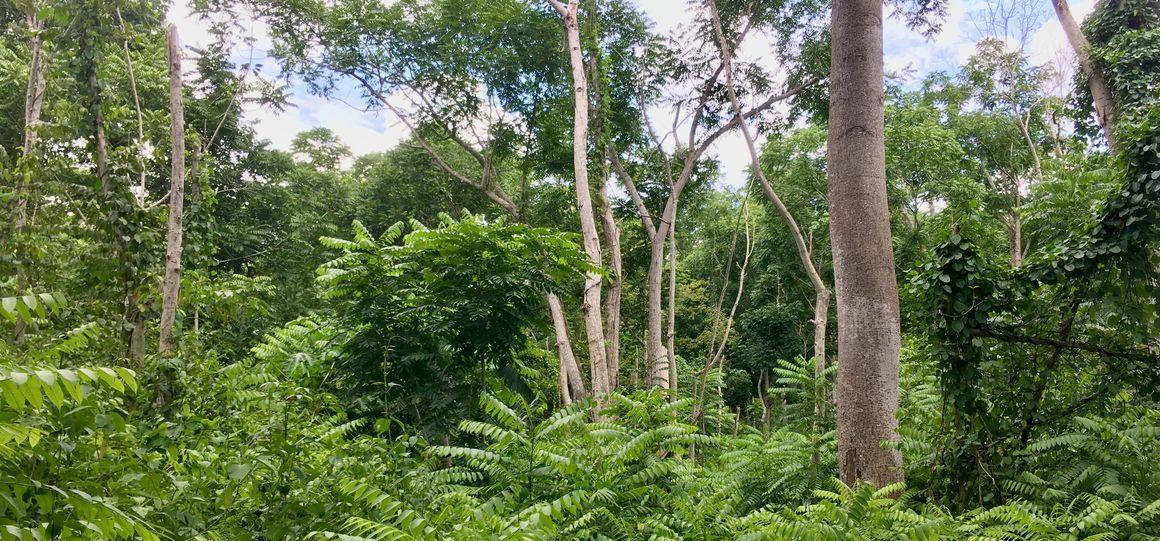Results & impact 10 October 2025
- Home
- Press area
- Press releases
- Forests: fires, invasive species, logging in Africa
Africa’s semi-deciduous forests are under threat

Invasion of undergrowth in the semi-deciduous forest in Téné (Ivory Coast) by the non-native species Cedrela odorata © B. Hérault, CIRAD
The study, conducted over a period of more than 30 years, analysed the response of 17 038 trees from 207 semi-deciduous forest species to three major disturbances – fire, logging and biological invasion – in a 100 hectare experimental plot. The researchers also examined the linkages between species-specific responses and functional traits related to resource acquisition and to defence strategies. The findings reveal significant threats to biodiversity in these forests.
A semi-deciduous forest is characterized by the partial shedding of leaves in the dry season. In West Africa, these forests are situated in a transition zone between the humid tropical forests of the South and the dry forests of the North. They support a rich diversity of plants, with the coexistence of humid forest species that transgress towards the North, dry forest species that transgress towards the South, and characteristic species that have adapted to these changing seasonal conditions.
"Our findings show that each of the three disturbances has had long-lasting negative impacts on the current abundance of species”, says Marie Ruth Dago, a PhD student at the Institut National Polytechnique Félix Houphouët-Boigny (Ivory Coast). “The species most sensitive to the disturbances are those with a conservative resource management strategy, such as a high density of leaf, wood and root tissues, and which invest little in defensive strategies, for example those with thin bark and leaves”, says Bruno Hérault, a forest ecologist at CIRAD.
Moreover, the study conducted as part of the RévaTéné project, funded by the AMRUGE Debt Reduction-Development Contract between Ivory Coast and France, shows that the species that are locally vulnerable to fire are also globally threatened species.
In the context of the massive deforestation of West African forests, the researchers propose several recommendations for the management of these ecosystems:
1. The conservation of the last remaining semi-deciduous forests – The protection of these zones is essential, given that opening them to logging simultaneously increases the risk of fire and the risk of biological invasion.
2. The use of native species in reforestation programmes – Avoiding the introduction of exotic species helps to limit the risk of biological invasion and to protect local biodiversity.
3. The implementation of fire control strategies in public policies – Measures to prevent and manage fires are needed to protect and restore these fragile forest ecosystems.
The study highlights the urgent need for specific actions to protect these unique ecosystems and their exceptional biodiversity.
References
Marie Ruth Dago, Irie Casimir Zo-Bi, Vincyane Badouard, Marco Patacca, Bruno Hérault,
Concomitant effects of multiple disturbances (logging, fire, biological invasion) on native tree abundances into West Africa's semi-deciduous forests. Biological Conservation, Volume 285, 2023. https://doi.org/10.1016/j.biocon.2023.110220
Van der Meersch, V., Zo-Bi, I.C., Amani, B.H.K. et al. Causes and consequences of Cedrela odorata invasion in West African semi-deciduous tropical forests. Biol Invasions 23, 537–552 (2021). https://doi.org/10.1007/s10530-020-02381-8
A recent study published in Nature, to which four CIRAD scientists contributed, explores the drivers of non-native tree invasions in ecosystems. The researchers used several global databases on tree distribution. The study shows that human factors play a crucial role in these invasions, while the diversity of indigenous tree species in ecosystems reduces their severity. Climate conditions, such as temperature and rainfall, also play a key role. Moreover, the study highlights a strong linkage between the proximity to major shipping ports and the risk of biological invasion. This research underlines the need to manage non-native species in order to preserve native ecosystems.
Invasive alien species (IAS), one of the five drivers of biodiversity loss, play a key role in 60% of global plant and animal extinctions, according to the latest IPBES report, published on 4 September. This report reveals that the annual costs are now estimated at more than 423 billion dollars; they have quadrupled every decade since 1970.
To find out more about IAS: IPBES Media Release dated 4 September



























